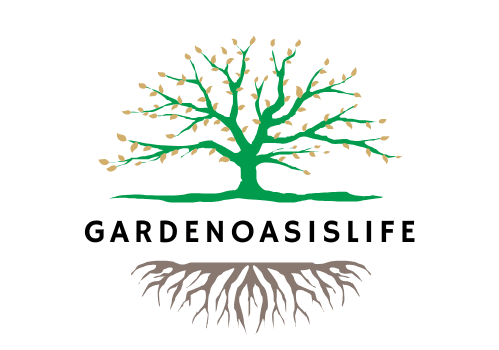Beautiful Purple Plants for Your Garden and Home
Purple plants can make your garden and home look elegant and dramatic. They come in soft, calming lavender and vibrant, bold magenta. These plants add a touch of violet beauty to any space. They’re perfect for creating a peaceful oasis or a bold focal point.
In this guide, we’ll look at many purple plants that grow well in different conditions. You’ll learn about the calming effect of purple and how to use these plants in your garden. We’ll also share tips on caring for these beautiful plants.
Key Takeaways
- Purple plants symbolize elegance, royalty, and creativity, offering a range of hues from soft lavender to vibrant magenta.
- Popular purple plants include fragrant lavenders, bold salvias, and stunning alliums, suitable for diverse garden styles and purposes.
- These plants vary in size, bloom time, and growing requirements, allowing gardeners to create captivating color palettes and texture combinations.
- Purple plants can attract pollinators, such as bees and butterflies, while also inviting hummingbirds to your outdoor oasis.
- Incorporating purple plants into your garden or home can have a calming, yet striking, effect on the overall aesthetic and atmosphere.
Why Choose Purple Plants for Your Space?
Purple plants bring elegance and sophistication to your home or garden. They offer a range of hues that can calm, excite, and attract pollinators. This makes them perfect for any outdoor oasis.
The Psychology of Color
The color purple is linked with royalty, luxury, and creativity. Adding purple plants can reduce stress and promote relaxation. Choose vibrant Salvia ‘Color Spires® Violet Riot’ or delicate Echinacea ‘Purple Emperor’ blooms to create a calming space.
Versatility in Landscaping
Purple plants match many colors, making them great for various garden designs. They add depth and interest to both formal and naturalistic gardens. Try different mauve foliage and plum blossoms to match your style.
Attracting Pollinators
Many purple plants attract butterflies and bees. Adding these plants to your garden supports local ecosystems. Enjoy the beauty of Echinacea ‘Purple Emperor’ and Salvia ‘Color Spires® Violet Riot’ as they attract pollinators.
“Purple plants evoke a sense of calmness and sophistication, making them a versatile choice for both indoor and outdoor spaces.”
Popular Purple Plants for Outdoor Gardens
Purple plants add elegance and sophistication to outdoor spaces. They attract pollinators and thrive in tough conditions. Let’s look at some popular purple plants for your garden.
Lavender: A Fragrant Favorite
Lavender is a classic garden choice, loved for its purple blooms and ability to handle drought. It grows well in well-drained soil and full sun. It’s perfect for amethyst botanicals beds, borders, or containers. Its scent and eggplant plants-like colors are a hit with gardeners.
Purple Coneflower: Beauty and Resilience
The mulberry leaves-colored purple coneflower is a native North American perennial. It’s beautiful and good for the environment. Its flowers attract butterflies and bees, and it grows well in many soils and climates.
Russian Sage: Hardiness Meets Elegance
Russian sage is a striking addition to gardens. It has mulberry leaves-colored blooms and silvery-green leaves. It’s known for its ability to handle drought, poor soil, and full sun. Its airy habit makes it great for borders, mass plantings, or as a focal point.
Lavender, purple coneflower, and Russian sage are all captivating. They add beauty and color to your outdoor space. Use them in your garden design for a stunning display.
| Plant | Height x Spread | Growing Zones | Key Features |
|---|---|---|---|
| Lavender | 45cm x 45cm | 5-9 | Aromatic flowers, drought-tolerant |
| Purple Coneflower | 90cm x 45cm | 3-9 | Attracts pollinators, hardy perennial |
| Russian Sage | 1.2m x 1m | 4-9 | Silvery foliage, drought-resistant |
Stunning Purple Indoor Plants
Elevate your indoor spaces with the enchanting presence of purple plants. These royal plant species captivate with their violet hues. They add charm and elegance to any room. Explore the allure of these stunning purple indoor plants and discover how they can transform your living environment.
African Violet: A Touch of Charm
The beloved African violet (Saintpaulia) is a compact and charming houseplant. It boasts an abundance of delicate, blooming petals in shades of purple. These low-maintenance plants thrive in bright, indirect light and require well-draining soil to maintain their vibrant color and healthy growth.
Purple Heart: A Trending Houseplant
The Purple Heart (Tradescantia pallida), also known as the Purple Queen, is a popular trailing houseplant. It adds a touch of regal elegance to any space. Its striking purple foliage and trailing habit make it a stunning addition to hanging baskets, shelves, or cascading over the edges of containers. These plants prefer bright, indirect light and well-draining soil to maintain their vibrant color.
Other captivating purple indoor plants include select varieties of Calathea, Orchids, and Persian. Each of these species has its own unique requirements. From low-light tolerant Calatheas to the bright, indirect light-loving Orchids. Carefully consider the individual needs of these plants to ensure they thrive and bring their stunning violet hues to life in your indoor oasis.
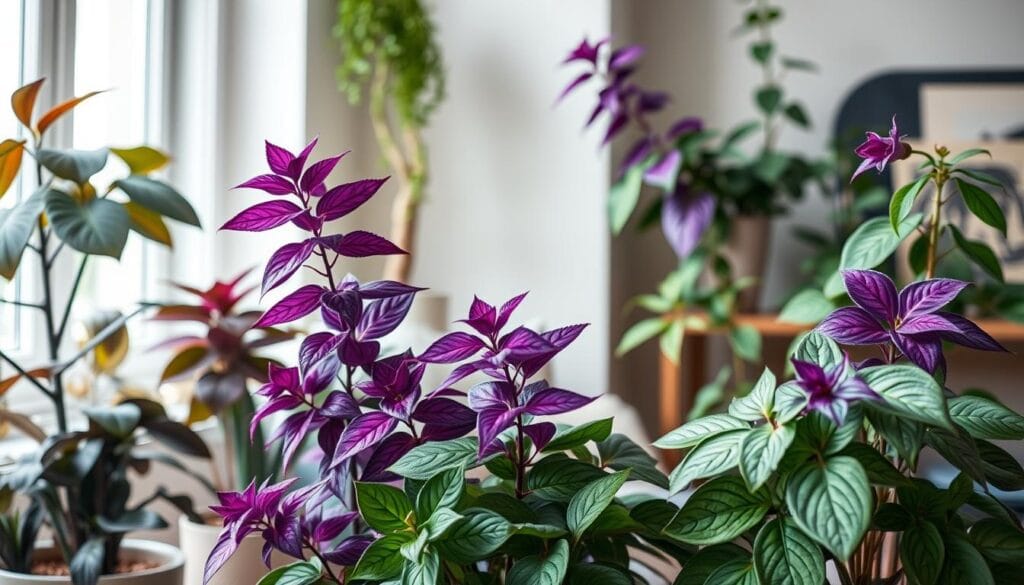
“The beauty of purple plants lies not only in their vibrant hues but also in their ability to uplift the spirit and evoke a sense of regality.”
How to Care for Purple Plants
Make your garden or home more beautiful with purple plants. You might love the scent of lavender flora, the bright plum blossoms, or the majestic mauve foliage. But, taking good care of them is key for them to grow well. Let’s look at what you need to do to help your purple plants.
Light Requirements
Purple plants need different amounts of light. Some, like Purple Heart, do best in partial shade. Others, like lavender and Russian sage, love full sun. Finding the right light is important for their health and color.
Soil Preferences
Purple plants like soil that drains well and is rich in nutrients. The best soil pH is slightly acidic to neutral. Adding organic matter can make the soil perfect for your purple plants.
Watering Tips
Watering needs differ among purple plants. Lavender likes dry soil, while Heliotrope needs it moist. Watch your plants closely and adjust watering to meet their needs. This keeps them healthy and happy.
“Embrace the captivating hues of purple plants to add a touch of regal elegance to your garden or home.”
Proper care and attention to each purple plant’s needs are crucial. Knowing their light, soil, and watering needs helps create a beautiful space. With the right care, your garden or home will be filled with lavender flora, plum blossoms, and mauve foliage, bringing joy and beauty.
Designing with Purple Plants
The color purple is known for its royal, sophisticated, and elegant vibe. Adding amethyst botanicals, eggplant plants, and mulberry leaves to your garden can make it look amazing. By picking the right colors and textures, you can make your garden a beautiful place.
Creating a Color Palette
Purple is a mix of red and blue, and it comes in many shades. You can use it with yellow, orange, and white for a bold look. Or, pair it with blues and silvers for a softer feel.
Combining Textures and Shapes
- Mix different textures, such as the spiky blooms of Allium with the soft petals of Petunias, to add visual interest.
- Vary plant shapes and sizes, like the tall and stately Russian Sage with the low-growing Verbena, to create a dynamic and eye-catching display.
- Consider bloom times to ensure a continuous flow of purple throughout the seasons, from the early-blooming Iris to the late-season Aster.
By choosing the right purple shades and adding different textures and shapes, you can make a stunning garden. The variety of amethyst botanicals, eggplant plants, and mulberry leaves lets you create a unique and magical garden.
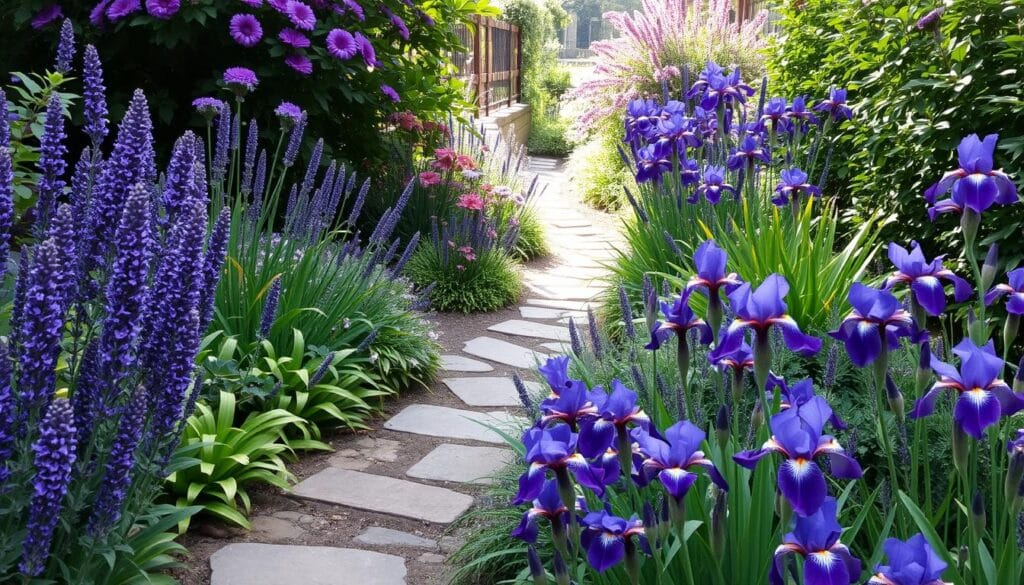
Seasonal Purple Blooms to Look For
As the seasons change, a vibrant array of purple plant species comes alive in gardens and homes. From the delicate blossoms of spring to the bold hues of summer and the rich tones of autumn, there’s a royal plant species to delight the senses at every stage.
Spring Blooms
Welcome the warmer months with the violet hues of early spring bloomers. Crocuses, Irises, and Lilacs burst forth, painting the landscape with their blooming petals. These resilient spring beauties thrive in plant zones 3-9, making them a reliable choice for gardens across the United States.
Summer Showstoppers
As summer arrives, royal plant species like Clematis, Petunias, and Lavender take center stage. The vibrant purple shades of these summer-loving plants create a striking contrast against the lush greenery. With their long-lasting blooms, these seasonal showstoppers are sure to captivate throughout the warmer months.
Autumn Colors
As the days grow shorter, Asters, Chrysanthemums, and some Dahlias bring a touch of purple to the autumn landscape. These late-season bloomers not only offer a stunning display of violet hues, but they also provide valuable nectar for pollinators as they prepare for winter.
By incorporating a diverse range of early, mid, and late-season purple plants, you can ensure a continuous flow of blooming petals in your garden or home. Some versatile options, like Verbena and Petunias, can even bloom from spring through fall with proper care, making them a valuable addition to any purple-themed planting scheme.
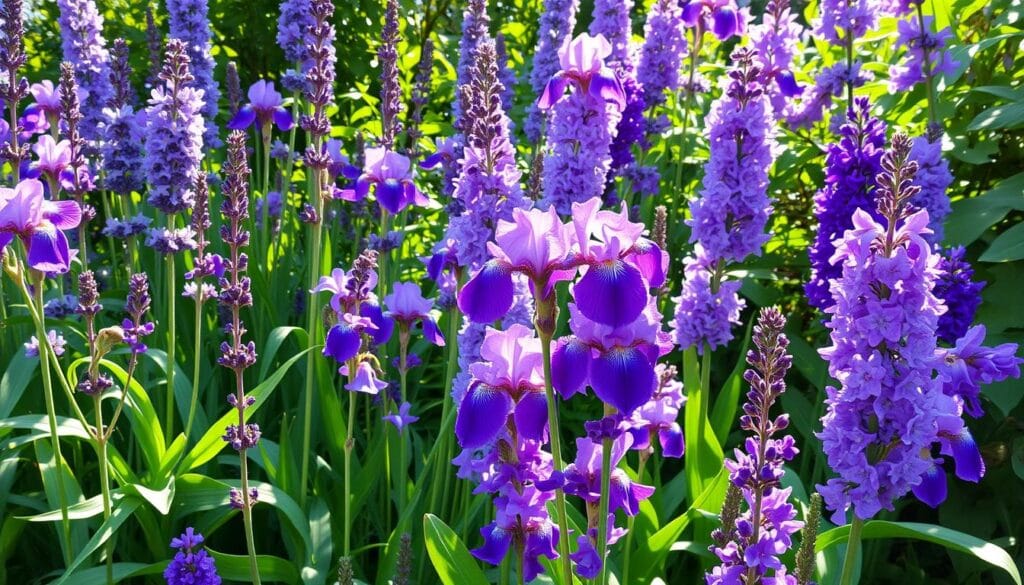
Purple Plants for Containers and Patio Gardens
Adding lavender, plum blossoms, and mauve foliage to your outdoor spaces is easy with container gardening. Plants like Heliotrope ‘Marine’ and Petunia ‘Supertunia® Royal Velvet®’ do well in pots. They’re perfect for patios, balconies, and small gardens.
Choosing the Right Pots
Choosing the right containers is crucial. Make sure they have good drainage to keep your plants healthy. You can pick from many shapes and sizes to add interest. Think about sleek urns or rustic clay pots.
Arrangement Ideas
- Pair upright plants like Salvia with trailing ones like Calibrachoa for a stunning look.
- Use big containers for shrubs like dwarf Buddleia to add height and structure.
- Place fragrant plants like Lavender or Heliotrope near where you sit to enjoy their scent.
With the right mix of lavender flora, plum blossoms, and mauve foliage, you can make your containers and patio vibrant. Be creative with your plant choices. Enjoy the beauty and versatility of purple in your outdoor spaces.
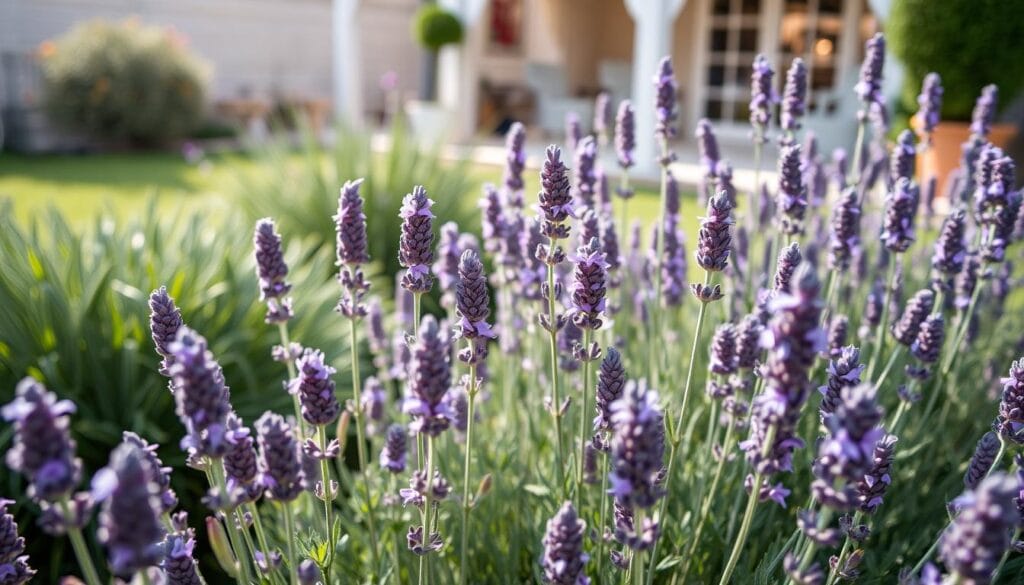
Common Pests and Problems
Keeping your garden healthy with amethyst botanicals, eggplant plants, and mulberry leaves is a big job. You need to watch out for pests and diseases. Spotting these problems early helps keep your plants looking great.
Identifying Pests
Aphids, spider mites, and whiteflies are common pests. Look for distorted leaves, sticky spots, or webs on your plants. Mealybugs, thrips, and Japanese beetles also cause trouble, each in their own way.
Diseases like powdery mildew can harm your plants, especially in damp weather. If leaves turn discolored, spotted, or wilt, it might be a disease.
Solutions for a Thriving Garden
To fight pests and keep your plants healthy, try these tips:
- Make sure plants have enough space for air to flow.
- Don’t water from above to prevent fungal diseases.
- Choose plants that are less likely to get sick.
- Use natural helpers like ladybugs or lacewings to fight aphids.
- Try insecticidal soaps or horticultural oils for pests, before using harsh chemicals.
By being careful and using the right methods, your purple plants will stay healthy. They’ll keep your garden or indoor space looking beautiful.
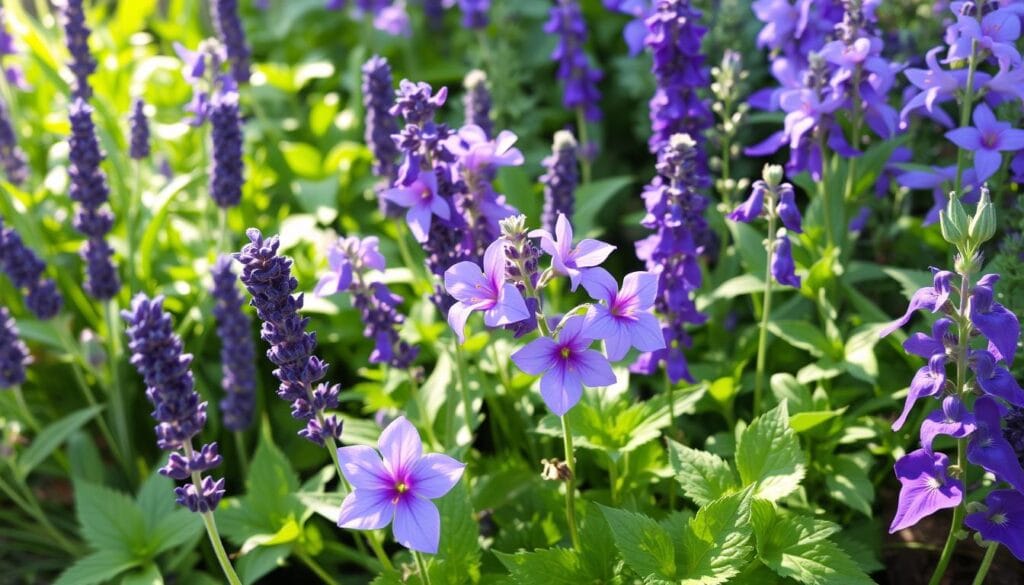
Conclusion: Embrace the Beauty of Purple Plants
Our journey through the world of purple plants has shown us their beauty. These royal plants are perfect for both inside and outside spaces. They bring elegance and sophistication with their calming lavender and dramatic violet hues.
Inviting Elegance into Your Home
Purple plants can make your home feel serene and welcoming. Whether you love the delicate charm of African violets or the bold look of Calathea Purple Rose, they’re great choices. They do well in different light conditions, fitting into both bright and dim areas.
Personalizing Your Garden Space
Purple plants can transform your garden. Imagine the scent of lavender fields or the beauty of Russian sage. These plants add depth and interest to your garden. By picking different purple shades, you can make a garden that’s truly yours.
